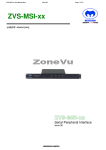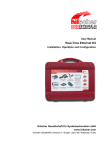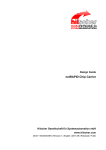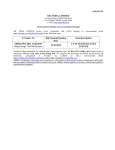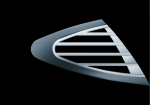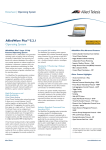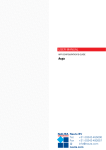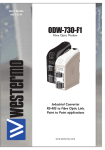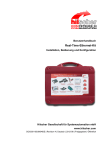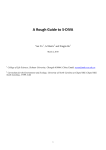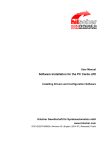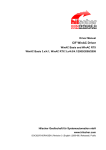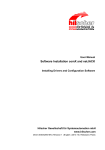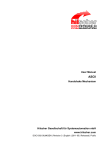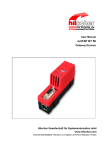Download NXIO 50-RE-Board - Hardware Description
Transcript
User Manual NXIO 50-RE-Board Hardware Description Hilscher Gesellschaft für Systemautomation mbH www.hilscher.com DOC090101UM06EN | Revision 6 | English | 2012-11 | Released | Public Introduction 2/47 Table of Contents 1 INTRODUCTION.........................................................................................................4 1.1 About the User Manual ...............................................................................................4 1.1.1 1.1.2 1.1.3 1.2 Reference to Hardware and Firmware........................................................................6 1.3 Contents of the Product CD........................................................................................6 1.4 Legal Notes.................................................................................................................7 1.4.1 1.4.2 1.4.3 1.4.4 1.4.5 2 2.1 General Note ............................................................................................................10 2.2 Intended Use ............................................................................................................10 2.3 Personnel Qualification.............................................................................................10 2.4 Safety Instructions to avoid Property Damage .........................................................10 2.5 Device Destruction by exceeding allowed Supply Voltage ................................10 Electrostatically sensitive Devices......................................................................11 Labeling of Safety Messages....................................................................................11 2.5.1 References Safety ..............................................................................................11 DESCRIPTION AND REQUIREMENTS ...................................................................12 3.1 Description................................................................................................................12 3.1.1 4 Copyright ..............................................................................................................7 Important Notes ....................................................................................................7 Exclusion of Liability .............................................................................................8 Warranty ...............................................................................................................8 Export Regulations ...............................................................................................9 SAFETY ....................................................................................................................10 2.4.1 2.4.2 3 Obligation to read and understand the Manual ....................................................4 List of Revisions ...................................................................................................4 Conventions in this Manual ..................................................................................5 netX50 Technology.............................................................................................13 3.2 Supply Voltage..........................................................................................................14 3.3 Requirements ...........................................................................................................14 DEVICE DRAWINGS AND CONNECTIONS ............................................................15 4.1 Power Supply............................................................................................................19 4.2 Types of the NXIO 50-RE Boards.............................................................................20 4.2.1 4.2.2 4.2.3 4.2.4 4.2.5 4.3 Property Damage Messages ....................................................................................22 4.3.1 4.3.2 4.4 NXIO 50-RE........................................................................................................20 NXIO 50-RE\CL ..................................................................................................20 NXIO 50-RE\CR .................................................................................................21 NXIO 50-RE\CN .................................................................................................21 NXIO 50-RE\CA..................................................................................................22 Device Destruction by exceeding allowed Supply Voltage ................................22 Electrostatically sensitive Devices......................................................................22 Possibilities of sticking NXIO 50 Boards togehter.....................................................23 NXIO 50-RE-Board | Hardware Description DOC090101UM06EN | Revision 6 | English | 2012-11 | Released | Public © Hilscher, 2009-2012 Introduction 3/47 4.4.1 4.4.2 5 CONFIGURATION ....................................................................................................25 5.1 PROFINET IO Device...............................................................................................25 5.1.1 5.1.2 5.2 5.3 General Data ......................................................................................................30 Configuring NXIO 50-RE for Open Modbus/TCP Server ...................................30 POWERLINK Controlled Node (Slave).....................................................................31 5.6.1 5.6.2 General Data ......................................................................................................31 Configuring NXIO 50-RE for POWERLINK Controlled Node (Slave) ................31 INTERFACES............................................................................................................32 6.1 Ethernet Interface .....................................................................................................32 6.1.1 6.1.2 6.1.3 6.2 7 General Data ......................................................................................................29 Configuring NXIO 50-RE for sercos ...................................................................29 Open Modbus/TCP Server .......................................................................................30 5.5.1 5.5.2 5.6 General Data ......................................................................................................28 Configuring NXIO 50-RE for EtherNet/IP Adapter (Slave) .................................28 SERCOS Slave.........................................................................................................29 5.4.1 5.4.2 5.5 General Data ......................................................................................................27 Configuring NXIO 50-RE for EtherCAT Slave....................................................27 EtherNet/IP Adapter (Slave) .....................................................................................28 5.3.1 5.3.2 5.4 General Data ......................................................................................................25 Configuring NXIO 50-RE for PROFINET IO.......................................................26 EtherCAT Slave ........................................................................................................27 5.2.1 5.2.2 6 Allowed Interconnections ...................................................................................23 Forbidden Interconnections................................................................................24 Ethernet pinning at the RJ45 Socket..................................................................32 Ethernet Connection Data ..................................................................................32 Use of Hubs and Switches .................................................................................33 Mini-B USB- Connector (5- Pin)................................................................................33 LEDS REAL-TIME-ETHERNET- SYSTEMS .............................................................34 7.1 LED Names of the Real-Time Ethernet Systems .....................................................34 7.2 SYS-LED ..................................................................................................................35 7.3 LEDs Real-Time Ethernet Protocols .........................................................................36 7.3.1 7.3.2 7.3.3 7.3.4 7.3.5 7.3.6 LED EtherCAT-Slave..........................................................................................36 LED EtherNet/IP-Adapter (Slave).......................................................................38 LED Open Modbus/TCP.....................................................................................39 LED POWERLINK Controlled Node / Slave.......................................................40 LED PROFINET IO-RT-Device ..........................................................................42 LED sercos Slave ...............................................................................................43 8 TECHNICAL DATA ...................................................................................................45 9 GLOSSARY...............................................................................................................46 10 CONTACTS...............................................................................................................47 NXIO 50-RE-Board | Hardware Description DOC090101UM06EN | Revision 6 | English | 2012-11 | Released | Public © Hilscher, 2009-2012 Introduction 1 4/47 Introduction 1.1 About the User Manual This User Manual contains a description about the configuration of the NXIO 50-RE board and a description of the hardware. 1.1.1 Obligation to read and understand the Manual Important! ! To avoid property damage to your device, you must read and understand all instructions in the manual and all accompanying texts to your device, before installing and operating your device. ! First read the Safety Instructions in the safety chapter. ! Obey to all Safety Messages in the manual. ! Keep the product DVD providing the product manuals. 1.1.2 List of Revisions Index Date Chapter Change 2 2009-03-12 all created 3 2010-07-01 1.2 Firmware versions updated Device Desciption files updated 4 4 5 6 2011-06-08 2011-11-25 2012-11-12 and meaning changed 4 Note about connector 10 added 7 Chapter LEDs Real-Time-Ethernet- Systems updated 5.1.1 revised 5.2.1 revised 5.3.1 revised 5.4.1 revised 5.5.1 revised 5.6.1 revised All Power Supply updated to 18 …30 V DC 1.2 Firmware versions updated 2 Chapter Safety revised. 4.3 Section Property Damage Messages added. 5.1.1 Name of GSDML file updated 5.6.1 Range for Node ID added. Table 1: List of Revisions NXIO 50-RE-Board | Hardware Description DOC090101UM06EN | Revision 6 | English | 2012-11 | Released | Public © Hilscher, 2009-2012 Introduction 1.1.3 5/47 Conventions in this Manual Operation instructions, a result of an operation step or notes are marked as follows: Operation Instructions: " <instruction> or 1. <instruction> 2. <instruction> Results: # <result> Notes: Important: <important note> Note: <note> <note, where to find further information> NXIO 50-RE-Board | Hardware Description DOC090101UM06EN | Revision 6 | English | 2012-11 | Released | Public © Hilscher, 2009-2012 Introduction 1.2 6/47 Reference to Hardware and Firmware Hardware Device Part Number Revision NXIO 50-RE 2521.100 2 NXIO 50-RE\CL 2521.101 2 NXIO 50-RE\CR 2521.102 2 NXIO 50-RE\CN 2521.103 2 NXIO 50-RE\CA 2521.104 2 Table 2: Reference to Hardware Firmware on MMC Card Firmware Protocol Firmware Version netx.rom Bootloader 1.0.3993 netx01.rom PROFINET IO Device 3.4.x.x netx02.rom EtherNet/IP Adapter 2.6.x.x netx03.rom EtherCAT Slave 2.5.x.x netx04.rom sercos Slave 3.1.x.x netx05.rom POWERLINK Controlled Node (Slave) 2.1.x.x netx06.rom Open Modbus Server 2.5.x.x Table 3: Reference to Firmware 1.3 Contents of the Product CD The product CD contains: • Documentation: User Manual (this document) • Schematic • Device Description Files (GSDML, XML, EDS) • Firmware NXIO 50-RE-Board | Hardware Description DOC090101UM06EN | Revision 6 | English | 2012-11 | Released | Public © Hilscher, 2009-2012 Introduction 1.4 1.4.1 7/47 Legal Notes Copyright © Hilscher, 2009-2012, Hilscher Gesellschaft für Systemautomation mbH All rights reserved. The images, photographs and texts in the accompanying material (user manual, accompanying texts, documentation, etc.) are protected by German and international copyright law as well as international trade and protection provisions. You are not authorized to duplicate these in whole or in part using technical or mechanical methods (printing, photocopying or other methods), to manipulate or transfer using electronic systems without prior written consent. You are not permitted to make changes to copyright notices, markings, trademarks or ownership declarations. The included diagrams do not take the patent situation into account. The company names and product descriptions included in this document may be trademarks or brands of the respective owners and may be trademarked or patented. Any form of further use requires the explicit consent of the respective rights owner. 1.4.2 Important Notes The user manual, accompanying texts and the documentation were created for the use of the products by qualified experts, however, errors cannot be ruled out. For this reason, no guarantee can be made and neither juristic responsibility for erroneous information nor any liability can be assumed. Descriptions, accompanying texts and documentation included in the user manual do not present a guarantee nor any information about proper use as stipulated in the contract or a warranted feature. It cannot be ruled out that the user manual, the accompanying texts and the documentation do not correspond exactly to the described features, standards or other data of the delivered product. No warranty or guarantee regarding the correctness or accuracy of the information is assumed. We reserve the right to change our products and their specification as well as related user manuals, accompanying texts and documentation at all times and without advance notice, without obligation to report the change. Changes will be included in future manuals and do not constitute any obligations. There is no entitlement to revisions of delivered documents. The manual delivered with the product applies. Hilscher Gesellschaft für Systemautomation mbH is not liable under any circumstances for direct, indirect, incidental or follow-on damage or loss of earnings resulting from the use of the information contained in this publication. NXIO 50-RE-Board | Hardware Description DOC090101UM06EN | Revision 6 | English | 2012-11 | Released | Public © Hilscher, 2009-2012 Introduction 1.4.3 8/47 Exclusion of Liability The software was produced and tested with utmost care by Hilscher Gesellschaft für Systemautomation mbH and is made available as is. No warranty can be assumed for the performance and flawlessness of the software for all usage conditions and cases and for the results produced when utilized by the user. Liability for any damages that may result from the use of the hardware or software or related documents, is limited to cases of intent or grossly negligent violation of significant contractual obligations. Indemnity claims for the violation of significant contractual obligations are limited to damages that are foreseeable and typical for this type of contract. It is strictly prohibited to use the software in the following areas: • for military purposes or in weapon systems; • for the design, construction, maintenance or operation of nuclear facilities; • in air traffic control systems, air traffic or air traffic communication systems; • in life support systems; • in systems in which failures in the software could lead to personal injury or injuries leading to death. We inform you that the software was not developed for use in dangerous environments requiring fail-proof control mechanisms. Use of the software in such an environment occurs at your own risk. No liability is assumed for damages or losses due to unauthorized use. 1.4.4 Warranty Although the hardware and software was developed with utmost care and tested intensively, Hilscher Gesellschaft für Systemautomation mbH does not guarantee its suitability for any purpose not confirmed in writing. It cannot be guaranteed that the hardware and software will meet your requirements, that the use of the software operates without interruption and that the software is free of errors. No guarantee is made regarding infringements, violations of patents, rights of ownership or the freedom from interference by third parties. No additional guarantees or assurances are made regarding marketability, freedom of defect of title, integration or usability for certain purposes unless they are required in accordance with the law and cannot be limited. Warranty claims are limited to the right to claim rectification. NXIO 50-RE-Board | Hardware Description DOC090101UM06EN | Revision 6 | English | 2012-11 | Released | Public © Hilscher, 2009-2012 Introduction 1.4.5 9/47 Export Regulations The delivered product (including the technical data) is subject to export or import laws as well as the associated regulations of different counters, in particular those of Germany and the USA. The software may not be exported to countries where this is prohibited by the United States Export Administration Act and its additional provisions. You are obligated to comply with the regulations at your personal responsibility. We wish to inform you that you may require permission from state authorities to export, re-export or import the product. NXIO 50-RE-Board | Hardware Description DOC090101UM06EN | Revision 6 | English | 2012-11 | Released | Public © Hilscher, 2009-2012 Safety 2 10/47 Safety 2.1 General Note The user manual, the accompanying texts and the documentation are written for the use of the products by educated personnel. When using the products, all Safety Messages, Safety Messages, Property Damage Messages and all valid legal regulations have to be obeyed. Technical knowledge is presumed. The user has to assure that all legal regulations are obeyed. 2.2 Intended Use The NXIO 50-RE Boards described in this manual are small modules for real-time Ethernet communication. Note: The NXIO 50-RE is in no way optimized in terms of EMC compatibility. This product is intended to be used for evaluation and development purposes in lab environments only and is not suitable for production use! 2.3 Personnel Qualification The NXIO devices must only be installed, configured, removed and used by qualified personnel. 2.4 Safety Instructions to avoid Property Damage To avoid property damage respectively device destruction to the devices and to your system, you necessarily must read, understand and follow the following safety instructions and safety messages in this manual about danger causing property damage, before you install and operate your devices. 2.4.1 Device Destruction by exceeding allowed Supply Voltage To avoid device destruction due to high supply voltage to your device, you must observe the following instructions. These instructions apply to all devices described in this manual. The device may only be operated with the specified supply voltage. Make sure that the limits of the allowed range for the supply voltage are not exceeded. A supply voltage above the upper limit can cause severe damage to the device! A supply voltage below the lower limit can cause malfunction of the device. The allowed range for the supply voltage is defined by the tolerances specified in this manual. The NXIO device may only be powered by a 24V DC ±6V supply voltage. NXIO 50-RE-Board | Hardware Description DOC090101UM06EN | Revision 6 | English | 2012-11 | Released | Public © Hilscher, 2009-2012 Safety 2.4.2 11/47 Electrostatically sensitive Devices This equipment is sensitive to electrostatic discharge, which cause internal damage and affect normal operation. Therefore adhere to the necessary safety precautions for components that are vulnerable with electrostatic discharge, if you install or replace your device. Follow the guidelines listed hereafter when you handle this equipment: • Touch a grounded object to discharge potential static. • Wear an approved grounding wriststrap. • Do not touch connectors or pins on the device. • Do not touch circuit components inside the equipment. • If available, use a static-safe workstation. • When not in use, store the equipment in appropriate static-safe packaging. Reference Safety [S3] 2.5 Labeling of Safety Messages Safety Symbol Sort of Warning or Principle Warning of Damages by Electrostatic Discharge Table 4: Safety Symbols and Sort of Warning or Principle Signal Word Note Meaning Meaning (USA) Indicates a Property Damage Message. Indicates a Property Damage Message. Indicates an important note in the manual. Indicates an Important Note in the Manual. Table 5: Signal Words In this document all Safety Instructions and Safety Messages are designed according both to the international used safety conventions as well as to the ANSI Z535 standard, refer to reference safety [S1]. 2.5.1 References Safety [S1] ANSI Z535.6-2006 American National Standard for Product Safety Information in Product Manuals, Instructions, and Other Collateral Materials [S2] IEC 60950-1, Information technology equipment - Safety Part 1: General requirements, (IEC 60950-1:2005, modified); German Edition EN 60950-1:2006 [S3] EN 61340-5-1 and EN 61340-5-2 as well as IEC 61340-5-1 and IEC 61340-5-2 NXIO 50-RE-Board | Hardware Description DOC090101UM06EN | Revision 6 | English | 2012-11 | Released | Public © Hilscher, 2009-2012 Description and Requirements 3 3.1 12/47 Description and Requirements Description The NXIO 50-RE boards described in this user manual are devices for Real-Time Ethernet communication. The board has two Ethernet sockets and is addressed by the same MAC address. The netX 50 controller exchanges data between the connected Ethernet network and the LEDs respectively the push buttons of the board. The NXIO 50-RE board has a loader software (in the serial Flash) to start the firmware from the MMC card automatically. Furthermore the board has two RJ45 Ethernet sockets for Real-Time Ethernet communication. A power supply with an output voltage in the range 18 to 30 V can be used. Note: The NXIO 50-RE is in no way optimized in terms of EMC compatibility. This product is intended to be used for evaluation and development purposes in lab environments only and is not suitable for production use! Depending on the firmware started from the MMC card the NXO 50-RE executes the on of the following Real-Time communication protocol: • PROFINET IO-Device • EtherCAT Slave • EtherNet/IP Adapter (Slave) • sercos Slave • Ethernet POWERLINK Controlled Node (Slave) • Open Modbus/TCP Server of the board selects the firmware, The position of the rotary switch which is loaded and started after power on respectively after pushing the reset button . NXIO 50-RE-Board | Hardware Description DOC090101UM06EN | Revision 6 | English | 2012-11 | Released | Public © Hilscher, 2009-2012 Description and Requirements 3.1.1 13/47 netX50 Technology The netX50 is a member of Hilscher’s family of highly integrated network controllers with a new system architecture optimized for communication and maximum data throughput. Based on the 32-Bit CPU ARM 966E-S clocked with 200 MHz, it provides a total of 112 KB internal RAM (including 8 KB instruction TCM and 8 KB data TCM) and 64 KByte ROM. Memory can be expanded flexibly by use of the 32-Bit memory controller allowing the connection of external SDRAM, SRAM or FLASH. Extensive periphal functions, serial interfaces, such as UART, USB, SPI, I²C, as well as the integrated IO-Link and CCD controller allow a large scope of applications. The central data switch and the free configurable communication channels with their own intelligence are the unique selling proposition of the netX as a “high end” network controller. Figure 1: netX50 Block Diagram The data switch provides five data paths, connecting the ARM CPU, the communication, Host and DMA controllers with the memory or the peripheral units. This allows all controllers to transmit their data in parallel, contrary to the traditional sequential architecture with only one common data bus and additional bus allocation cycles. The identical set of controllers of the two communication channels are structured on two levels. They consist of dedicated ALUs and special logic units that receive their protocol functions via Microcode. For Ethernet the PHYs are integrated which means that the external circuit for Ethernet is reduced to passive componets: transformer and RC components. The Medium-Access-Controller xMAC sends or receives the data according to the respective bus access process and encrypts or converts these into Byte depictions. NXIO 50-RE-Board | Hardware Description DOC090101UM06EN | Revision 6 | English | 2012-11 | Released | Public © Hilscher, 2009-2012 Description and Requirements 14/47 The Protocol Execution Controller xPEC compiles these into data packets and controls the telegram traffic. Large data amoutns are exchanged in DMA blocks over the memory of the ARM. In addition, every channel has a Dual-port-memory available for status information. Alternatively a triple buffer logic is implemented for a conflict free data exchange which always gives the address of the next free buffer. With the intelligent communication ALUs, the netX carries out the most varied protocols and protocol combinations on one chip – an absolutely new feature in industrial communication technology. 3.2 Supply Voltage The following table provides the required and permissible supply voltage of the NXIO devices. Hardware Supply Voltage NXIO 50-RE\CA, 24V DC / 500mA / 2,6W NXIO 50-RE\CL, +18 ... +30 V DC NXIO 50-RE\CR, NXIO 50-RE\CN Table 6: Supply Voltage Voltage NXIO Devices 3.3 Requirements The following requirements have to be fulfilled for operation: • DC power supply with 18 - 30 V (DC) output voltage, power consumption approximately. 2,6 W per Board. • Communication Master • Ethernet cable • Firmware on plugged MMC card NXIO 50-RE-Board | Hardware Description DOC090101UM06EN | Revision 6 | English | 2012-11 | Released | Public © Hilscher, 2009-2012 Device Drawings and Connections 4 15/47 Device Drawings and Connections The following figure shows the position of the operating elements, interfaces and LEDs on the board. Figure 2: Layout of the NXIO 50-RE Board Position Number Type Function Pushbutton Reset LED LED COM1 – communication status 1 Connector Ethernet CH 0 and power supply LED LED COM0 – communication status 0 LED LED SYS – system status Mini-B USB Connector Without function RJ45 Socket Ethernet CH 0 LED Ethernet CH 0: Rx/Tx, ACT LED Ethernet CH 0: LINK Connector strip Trigger signals MMD-Card Connector To hold the MMC card with the protocol firmware. LED Input signal Bit 31, from pushbutton Socket terminal strip Ethernet CH 0 and power supply LED Input signal Bit 16, from push button NXIO 50-RE-Board | Hardware Description DOC090101UM06EN | Revision 6 | English | 2012-11 | Released | Public © Hilscher, 2009-2012 Device Drawings and Connections Position Number 16/47 Type Function LED Input signal Bit 15, from push button Pushbutton Pushbutton input Bit 31 Pushbutton Pushbutton input Bit 16 Pushbutton Pushbutton input Bit 15 Pushbutton Pushbutton input Bit 0 Rotary switch Address switch (HIGH) *16, 0 … 15 (0 … F). Rotary switch Address switch (LOW), 0 … 15 (0 … F). Socket terminal strip Ethernet CH 1 and power supply LED’s Output signals Bit 0 … 31 LED Input signal Bit 15, from push button Rotary switch Firmware selection switch 1 netx01.rom – PROFINET IO 2 netx02.rom – EtherNet/IP 3 netx03.rom – EtherCAT 4 netx04.rom – sercos 5 netx05.rom – POWERLINK 6 netx06.rom – Open Modbus/TCP 7..F Socket No protocol assigned Power supply 24 V DC, ±6 V, max.0,5 A Outside = GND, Inside = +24 V For barrel connector: (ø5.5/ø2.1) L12 mm Terminal Power supply 24V DC, ±6 V Pin 1 = GND; Pin 2 = +24V LED Ethernet CH 1: LINK LED Ethernet CH 1: Rx/Tx, ACT RJ 45 Socket Ethernet CH 1 Socket terminal strip Ethernet CH 1 and power supply Table 7: Operator elements, interfaces and LEDs of the NXIO 50-RE Board NXIO 50-RE-Board | Hardware Description DOC090101UM06EN | Revision 6 | English | 2012-11 | Released | Public © Hilscher, 2009-2012 Device Drawings and Connections 17/47 Pin assignment connector : Pin Signal Meaning 1 GND Ground +24 V Power supply 5 CH0 TX+ Ethernet Channel 0: transmit data + 6 CH0 TX– Ethernet Channel 0: transmit data - 7 CH0 RX+ Ethernet Channel 0: receipt data + 8 CH0 RX– Ethernet Channel 0: receipt data - 2 3 4 Table 8: Pin assignment of multi-pin connector 3 Pin assignment connector Pin Signal Meaning 1 GND Ground : 2 3 PIO39 OUT (LED 0) 4 PIO85 IN 1 5 PIO84 IN 2 6 IOTRIG Hardware Oszillator 25 Hz (20 ms High, 20 ms Low) 7 SAMLPE0 Not busy 8 SAMLPE1 Not busy 9 TRIG0 sercos: Con_Clk EtherCAT: Sync 0 Out 10 TRIG1 sercos: Nicht belegt EtherCAT: Sync 1 Out Table 9: Signals of multi-pin connector 10 The connector pins 3 .. 6 have an in / output level of 3,3 V and a pullupresistor of 50 KΩ. These are not short-circuit-proof! The connector pins 7 .. 10 have an in / output level of 3,3 V and a pulldownresistor of 50 KΩ. These are not short-circuit-proof! Note: The pins of connector are for oscilloscope measurements only. NXIO 50-RE-Board | Hardware Description DOC090101UM06EN | Revision 6 | English | 2012-11 | Released | Public © Hilscher, 2009-2012 Device Drawings and Connections 18/47 Pin assignment connector : Pin Signal Meaning 1 GND Ground +24 V Power supply 5 CH0 TX– Ethernet Channel 0: transmit data – 6 CH0 TX+ Ethernet Channel 0: transmit data + 7 CH0 RX– Ethernet Channel 0: receipt data – 8 CH0 RX+ Ethernet Channel 0: receipt data + 2 3 4 Table 10: Signals of multi-pin connector 13 Pin assignment connector Pin Signal : Meaning 1 CH1 TX– Ethernet Channel 1: transmit data – 2 CH1 TX+ Ethernet Channel 1: transmit data + 3 CH1 RX– Ethernet Channel 1: receipt data – 4 CH1 RX+ Ethernet Channel 1: receipt data + 5 +24 V Power supply GND Ground 6 7 8 Table 11: Signals of multi-pin connector 22 Pin assignment connector : Pin Signal Meaning 1 CH1 TX+ Ethernet Channel 1: transmit data + 2 CH1 TX– Ethernet Channel 1: transmit data – 3 CH1 RX+ Ethernet Channel 1: receipt data + 4 CH1 RX– Ethernet Channel 1: receipt data ten – 5 +24 V Power supply GND Ground 6 7 8 Table 12: Signals of multi-pin connector 31 NXIO 50-RE-Board | Hardware Description DOC090101UM06EN | Revision 6 | English | 2012-11 | Released | Public © Hilscher, 2009-2012 Device Drawings and Connections 4.1 19/47 Power Supply The NXIO 50-RE Board can be operated by a DC power supply from 18V to 30V. The connector for the power supply are on the right side: and . The power consumption per Board is 2,6 W. The polarity of the power plug has to be considered. No alternating (AC) power supply can be used, because the board is not designed for this type of power supply. The current consumption depends on different factors, for example the operating mode of the netX, CPU load, usage of additional hardware and mainly from the level of the real input voltage (the higher the voltage the lower the current). Pin Description 1 Ground 2 18 - 30 V DC The power connector is fitting for the power supply: NXAC-Power. Technical Data of: NXAC-Power Input: 100-240 V ~0,4 A (47-63 Hz) Output: 24 V / 0,625 mA with barrel connector cable length:1,8 m Order number: 7930.000 NXIO 50-RE-Board | Hardware Description DOC090101UM06EN | Revision 6 | English | 2012-11 | Released | Public © Hilscher, 2009-2012 Device Drawings and Connections 4.2 20/47 Types of the NXIO 50-RE Boards The board is available in 4 different types and a connection board. In the following drawings the left drawing shows assembly view and the right drawing the signal flow/voltage feed. 4.2.1 NXIO 50-RE Order number: 2521.100 This board has 2 RJ45 Sockets to connect Ethernet cables. It can be used as an independent board. 4.2.2 NXIO 50-RE\CL Order number: 2521.101 This board has 1 RJ45 socket on the left and is usable for a cable free connection (on the right) to additionally NXIO 50 boards. The second Ethernet connection is designed as multi-pin /multipoint connector. Via this multi-pin/multipoint connector other NXIO 50 board can be connected. The power supply is connected through. NXIO 50-RE-Board | Hardware Description DOC090101UM06EN | Revision 6 | English | 2012-11 | Released | Public © Hilscher, 2009-2012 Device Drawings and Connections 4.2.3 21/47 NXIO 50-RE\CR Order number: 2521.102 This board has 1 RJ45 socket on the right and is usable for a cable free connection (on the left) to additionally NXIO 50 boards. The second Ethernet connection is designed as multi-pin /multipoint connector. Via this multi-pin/multipoint connector other NXIO 50 board can be connected. The power supply is connected through. 4.2.4 NXIO 50-RE\CN Order number: 2521.104 This board has no RJ45 socket and is usable for a cable free connection (on the left and the right) to additionally NXIO 50 boards. The Ethernet connections are designed as multi-pin /multipoint connectors. Via this multipin/multipoint connectors other NXIO 50 board can be connected. The power supply is connected through. NXIO 50-RE-Board | Hardware Description DOC090101UM06EN | Revision 6 | English | 2012-11 | Released | Public © Hilscher, 2009-2012 Device Drawings and Connections 4.2.5 22/47 NXIO 50-RE\CA Order number: 2521.103 This Ethernet connection board with RJ45 sockets is usable as adapter for the NXIO 50-RE\CN, NXIO 50-RE\CL and NXIO 50-RE\CR boards to make it possible to connect external devices via Ethernet sockets. Additionally a connection for power supply of the NXIO 50 boards sticked together is done. 4.3 Property Damage Messages Obey to the following property damage messages, when installing your device. 4.3.1 Device Destruction by exceeding allowed Supply Voltage Device Destruction! ! Use only the permissible supply voltage to operate the device. ! The device may only be powered by a 24V DC ±6V supply voltage. 4.3.2 Electrostatically sensitive Devices Adhere to the necessary safety precautions for components that are vulnerable with electrostatic discharge. Electrostatically sensitive Devices ! To prevent damage to the PC and the device, make sure that you are discharged when you touch the device. NXIO 50-RE-Board | Hardware Description DOC090101UM06EN | Revision 6 | English | 2012-11 | Released | Public © Hilscher, 2009-2012 Device Drawings and Connections 4.4 23/47 Possibilities of sticking NXIO 50 Boards togehter The advantage of these boards is that they can connected togheter without an Ethernet cable. The Ethernet frames that are not fort he NXIO board are going from Port 0 to 1 respectively from Port 1 to 0. A maxium of 5 boards can be used with one power supply. If more than 5 boards in an Ethernet network are used, then groups of maximum of 5 devices have to be installed. These groups have to be connected with an Ethernet cable. Each group needs it own power supply. 4.4.1 Allowed Interconnections Basically the interconnection of boards is allowed in two lines. The Ethernet connection on the NXIO 50-RE\CA adapter can be used to connect additionally devices and then is connected back to the NXIO 50-RE\CA adapter. The maximum installation of NXIO boards regarding the power supply. NXIO 50-RE-Board | Hardware Description DOC090101UM06EN | Revision 6 | English | 2012-11 | Released | Public © Hilscher, 2009-2012 Device Drawings and Connections 4.4.2 24/47 Forbidden Interconnections Basically interconnections with more than one Ethernet connection on one port is forbidden. In the interconnection above is either the red crossed NXIO 50-RE\CA ort he red crossed NXIO 50-RE\CN forbidden. Only one of these boards is allowed. In the interconnection above is one of the red crossed NXIO 50-RE\CN boards forbidden. NXIO 50-RE-Board | Hardware Description DOC090101UM06EN | Revision 6 | English | 2012-11 | Released | Public © Hilscher, 2009-2012 Configuration 5 25/47 Configuration The protocol is selected with the rotary switch of the board. This is only of the board a SD/MMC card with firmware files on possible when in slot it is inserted in the slot. 5.1 5.1.1 PROFINET IO Device General Data Real-Time Ethernet System Position 1 Protocol rotary switch Address rotary switches PROFINET IO-Device and Definition for the name of Station Rotary switch Rotary switch name of station 0 1 nxio50repns-01 0 2 nxio50repns-02 0 3 nxio50repns-03 GSDML (Device description file) GSDML-V2.2-HILSCHER-NXIO 50 RE PNSxxxxxxxx.xml (on CD) System Requirements PROFINET IO Controller Support USB Current Firmware has no USB Support I/O Data 4 Byte Input, (Bit 0, 15, 16, 31 with push button switchable) 4 Byte Output (LED) Communication PROFINET IO RT VLAN- and Priority-tagging Functions Cyclic Process Data DCP Context Management over CLRPC Target/Actual Configuration Comparison Table 13: General Data PROFINET IO Device NXIO 50-RE-Board | Hardware Description DOC090101UM06EN | Revision 6 | English | 2012-11 | Released | Public © Hilscher, 2009-2012 Configuration 5.1.2 26/47 Configuring NXIO 50-RE for PROFINET IO 1. Verify that a SD/MMC card with the firmware files on it is inserted in slot of the board. 2. The protocol switch of the NXIO 50 board must be set to 1. 3. Set the name with which the board will later be identified with the and ) on the NXIO 50 board. address switch ( 4. Connect the power supply to the NXIO 50-RE Board. 5. Connect the boards/devices with Ethernet cables. Add switches if necessary. If you use only NXIO 50-RE boards for your installation then no switch is necessary. Communication System Hub Switch PROFINET IO forbidden applicable (100 MBit/s, Full duplex) Table 14: Use of Hubs and Switches for PROFINET IO 6. Press the Reset push button from the board. of the board that the firmware is loaded 7. If you like to change the default name of station for the NXIO 50 board then use the program Ethernet Device Configuration. Note: For further information refer to the operation instruction manual Ethernet Device Configuration (Setting IP Address for Ethernet compatible Hilscher Devices using the DCP Protocol, ENDevCfg_en.pdf). 8. Configure the Master. NXIO 50-RE-Board | Hardware Description DOC090101UM06EN | Revision 6 | English | 2012-11 | Released | Public © Hilscher, 2009-2012 Configuration 5.2 5.2.1 27/47 EtherCAT Slave General Data Real-Time Ethernet System Protocol rotary switch EtherCAT Slave Set protocol rotary switch to position 3 Address rotary switches Not used XML Hilscher NXIO 50-RE ECS.xml (on CD) System Requirements EtherCAT Master Support USB Current firmware has no USB support I/O Data 4 ByteInput (Bit 0, 15, 16 and 31 with push button switchable) 4 Byte Output (LED) Acyclic Data 128 Bytes Mailbox Out 128 Bytes Mailbox In Functions Complex Slave COE (CANopen over Ethernet) Distributed Clock Table 15: General Data EtherCAT Slave 5.2.2 Configuring NXIO 50-RE for EtherCAT Slave 1. Verify that a SD/MMC card with the firmware files on it is inserted in slot of the board. 2. The protocol switch of the NXIO 50 board must be set to 3. 3. Connect the power supply to the NXIO 50-RE Board. 4. Connect the boards/devices with Ethernet cables. Communication System Hub Switch EtherCAT forbidden applicable only between Master and 1. participant Table 16: Use of Hubs and Switches for EtherCAT 5. Press the Reset push button from the board. of the board that the firmware is loaded 6. Configure the Master. NXIO 50-RE-Board | Hardware Description DOC090101UM06EN | Revision 6 | English | 2012-11 | Released | Public © Hilscher, 2009-2012 Configuration 5.3 5.3.1 28/47 EtherNet/IP Adapter (Slave) General Data Real-Time Ethernet System EtherNet/IP Adapter (Slave) Set protocol rotary switch to position 2. Protocol rotary switch Address rotary switches and EDS (Device description file) Set both address rotary switches to F. Then the saved configuration is loaded and DHCP is used for startup. HILSCHER NXIO50 EIS 1.1.EDS (of CD) System Requirements EtherNet/IP Scanner / Master For the start after power on or reset the IP address must be assigned via the DHCP server Support USB Current firmware has no USB support I/O Data 4 Byte Input, (Bit 0, 15, 16, 31 with push button switchable) 4 Byte output (LED) 1 I/O connection (cyclic), up to 2 'Listen only', up to 2 'Input only' Communication Acyclic Communication Get_Attribute_Single Get_Attribute_All Set_Attribute_Single Set_Attribute_All IP Address Via DHCP Table 17: General Data EtherNet/IP Adapter (Slave) 5.3.2 Configuring NXIO 50-RE for EtherNet/IP Adapter (Slave) 1. Verify that a SD/MMC card with the firmware files on it is inserted in slot of the board. 2. The protocol switch of the NXIO 50 board must be set to 2. 3. Connect the power supply to the NXIO 50-RE Board. 4. Connect the boards/devices with Ethernet cables. Communication System Hub Switch EtherNet/IP applicable applicable Table 18: Use of Hubs and Switches for EtherNet/IP 5. Start the DHCP server 6. Press the Reset push button from the board. of the board that the firmware is loaded 7. Configure the Master. NXIO 50-RE-Board | Hardware Description DOC090101UM06EN | Revision 6 | English | 2012-11 | Released | Public © Hilscher, 2009-2012 Configuration 5.4 5.4.1 29/47 SERCOS Slave General Data Real-Time Ethernet System Set protocol rotary switch to position 4. Protocol rotary switch Address rotary switches sercos Slave and SDDML (Device description file) Device address from 1 to 127 Hilscher NXIO50 RE S3S FSPIO FixCFG.xml (on CD) System Requirements sercos Master Firmware Support USB Current firmware has no USB support. I/O Data 4 Byte Input, (Bit 0, 15, 16, 31 with push button switchable) 4 Byte Output (LED) SVC or cyclically configurable. Functions Real-Time Data Service Channel Ring or Line Topology Synchronization CON_CLK, DIV_CLK Table 19: General Data sercos Slave 5.4.2 Configuring NXIO 50-RE for sercos 1. Verify that a SD/MMC card with the firmware files on it is inserted in slot of the board. 2. The protocol switch 3. Set the address switch of the NXIO 50 board must be set to 4. (*16) and the address switch (*1). 4. Connect the power supply to the NXIO 50-RE Board. 5. Connect the boards/devices with Ethernet cables. 6. Connect the devices using Ethernet cable. (Hubs and switches are forbidden). 7. Configure the Master. NXIO 50-RE-Board | Hardware Description DOC090101UM06EN | Revision 6 | English | 2012-11 | Released | Public © Hilscher, 2009-2012 Configuration 5.5 5.5.1 30/47 Open Modbus/TCP Server General Data Real-Time Ethernet System Protocol rotary switch Open Modbus/ TCP Server Set protocol rotary switch to position 6. Address rotary switches Not used EDS (Device description file) Not necessary System Requirements Open Modbus TCP Client: e. g. ModScan32 Firmware Support USB Current firmware has no USB support. I/O Modbus Server 4 Byte Input, (Bit 0, 15, 16, 31 with push button switchable) IP Address via DHCP 4 Byte Output (LED) Function Codes 1, 2, 3, 4, 5, 6, 7, 15, 16 Function Code 1: 1 ..........32 (coil read) Function Code 2: 10001 ....10032 (2 register read) Function Code 3: 40001 ....40002 (2 register read) Function Code 4: 30001 ....30002 (2 register read) Function Code 5: (coil write) 1 ..........32 Function Code 6: 40001 ....40002 (2 register write) Function Code 15: (coil write) 1 ..........32 Function Code 16: 40001 ....40002 IP Address via DHCP Message Modus Server (2 register write) Table 20: General Data Open Modbus/TCP Server 5.5.2 Configuring NXIO 50-RE for Open Modbus/TCP Server 1. Verify that a SD/MMC card with the firmware files on it is inserted in slot of the board. 2. The protocol switch of the NXIO 50 board must be set to 6. 3. Connect the power supply to the NXIO 50-RE Board. 4. Connect the boards/devices with Ethernet cables. Add switches or hubs if necessary. If you use only NXIO 50-RE boards for your installation then no switch is necessary. Communication System Hub Switch Open Modbus/TCP applicable applicable Table 21: Use of Hubs and Switches for Open Modbus/TCP 5. Configure the Client. NXIO 50-RE-Board | Hardware Description DOC090101UM06EN | Revision 6 | English | 2012-11 | Released | Public © Hilscher, 2009-2012 Configuration 5.6 5.6.1 31/47 POWERLINK Controlled Node (Slave) General Data Real-Time Ethernet System Ethernet POWERLINK Controlled Node (Slave) Set protocol rotary switch to position 5. Protocol rotary switch Address rotary switches and Node ID of the Ethernet POWERLINK Controlled Node from 01 hex to EF hex (1 … 239 dec). Node ID 1: is 0 and is 1, … Node ID 239: is E and is F. XDD (Device description file) 00000044_NXIO 50-RE PLS.xdd (on CD) Parameters set by the firmware All configuration data as PDO configuration etc. Support USB Current firmware has no USB support I/O Data 4 Byte Input, (Bit 0, 15, 16, 31 with push button switchable) 4 Byte output on LEDs Functions Integrated Hub SDO Up-/Download SDO over ASND Poll Request/ Response Response Time 1µs Version V2 Table 22: General Data POWERLINK Controlled Node (Slave) 5.6.2 Configuring NXIO 50-RE for POWERLINK Controlled Node (Slave) 1. Verify that a SD/MMC card with the firmware files on it is inserted in slot of the board. 2. The protocol switch of the NXIO 50 board must be set to 5. 3. Connect the power supply to the NXIO 50-RE Board. 4. Connect the boards/devices with Ethernet cables. Add hubs if necessary. If you use only NXIO 50-RE boards for your installation then no switch is necessary. Communication System Hub Switch POWERLINK applicable forbidden Table 23: Use of Hubs and Switches 5. Configure the Master. NXIO 50-RE-Board | Hardware Description DOC090101UM06EN | Revision 6 | English | 2012-11 | Released | Public © Hilscher, 2009-2012 Interfaces 6 32/47 Interfaces 6.1 Ethernet Interface For the Ethernet interface use RJ45 plugs and twisted pair cable of category 5 (CAT5) or higher, which consists of 4 twisted cores and has a maximum transmission rate of 100 MBit/s (CAT5). 6.1.1 Ethernet pinning at the RJ45 Socket Note: The device supports the Auto Crossover function. Due to this fact RX and TX can be switched. The following figure shows the RJ45 standard pinning. Figure 3: Ethernet pinning at the RJ45 Socket Pin Signal Meaning 1 TX+ Transmit Data + 2 TX– Transmit Data – 3 RX+ Receive Data + 4 Term 1 5 Term 1 Connected to each other and terminated to PE through RC circuit* 6 RX– Receive Data – 7 Term 2 8 Term 2 Connected to each other and terminated to PE through RC circuit* * Bob Smith Termination Table 24: Ethernet-Pin-Assignment RJ45 6.1.2 Ethernet Connection Data Medium 2 x 2 Twisted-Pair cupric cable, CAT5 (100 MBit/s) Length of cable max. 100 m Transmission rate 10 MBit/s / 100 MBit/s Table 25: Ethernet Connection Data NXIO 50-RE-Board | Hardware Description DOC090101UM06EN | Revision 6 | English | 2012-11 | Released | Public © Hilscher, 2009-2012 Interfaces 6.1.3 33/47 Use of Hubs and Switches For the corresponding communication systems the use of hubs and switches is forbidden or applicable. The following table shows the use of hubs and switches by communication system: Communication System Hub Switch EtherCAT forbidden applicable only between Master and 1. participant EtherNet/IP allowed applicable (10 MBit/s / 100 MBit/s, Full or Half Duplex, Auto-Negotiation) Open Modbus/TCP allowed applicable (10 MBit/s / 100 MBit/s, Full or Half Duplex, Auto-Negotiation) POWERLINK Controlled Node allowed forbidden PROFINET IO forbidden applicable only, if the switch supports ‘priority tagging’ (100 MBit/s, Full duplex) sercos forbidden forbidden Table 26: Use of Hubs and Switches 6.2 Mini-B USB- Connector (5- Pin) Figure 4: Mini-B USB Connector (5 Pin), X2 Pin Name Description 1 USB_EXT USB Bus Power (+5 V, supplied externally) 2 D- Data - 3 D+ Data + 4 ID Not connected 5 GND Ground Table 27: Pin assignment X2 This interface is not supported by the current firmware. NXIO 50-RE-Board | Hardware Description DOC090101UM06EN | Revision 6 | English | 2012-11 | Released | Public © Hilscher, 2009-2012 LEDs Real-Time-Ethernet- Systems 7 7.1 34/47 LEDs Real-Time-Ethernet- Systems LED Names of the Real-Time Ethernet Systems EtherCAT Slave EtherNet/IP POWERLINK Open Modbus/TCP PROFINET IO sercos Slave Note: Depending from the configured MMC card the NXIO 100-RE Board LEDs are configured to the corresponding real-time Ethernet system. SYS SYS SYS SYS SYS SYS RUN MS BS RUN SF S3 ERR NS BE ERR BF - L/A IN LINK L/A LINK LINK L/A - ACT - ACT RX/TX - L/A OUT LINK L/A LINK LINK L/A - - ACT RX/TX - NXIO 50-LED’s SYS (yellow / green) COM 0 (red/ green) COM 1 (red/ green) RJ45 Ch0 green yellow RJ45 Ch1 green yellow ACT Table 28: LED Names for each Real Time Ethernet System LED Name Meaning System Status SYS System Communication Status RUN Run ERR Error S3 sercos Status STA Status SF System Failure BF Bus Failure MS Module Status NS Network Status BS Bus Status BE Bus Error LINK, L Link ACT, A Activity L/A Link/Activity L/A IN Link/Activity Input L/A OUT Link/Activity Output RJ45 Table 29: Meaning LED Names NXIO 50-RE-Board | Hardware Description DOC090101UM06EN | Revision 6 | English | 2012-11 | Released | Public © Hilscher, 2009-2012 LEDs Real-Time-Ethernet- Systems 7.2 35/47 SYS-LED This LED indicates important operating states of the board. LED SYS Color State Meaning green On Operating System running. yellow Flashing cyclic with 1Hz Device indicates boot error. yellow static Bootloader is waiting for booting procedure. - Off Power supply for the device is missing or hardware defect. Table 30: SYS-LED To determine the position of the LED use the device drawings in section Device Drawings and Connections on page 15. NXIO 50-RE-Board | Hardware Description DOC090101UM06EN | Revision 6 | English | 2012-11 | Released | Public © Hilscher, 2009-2012 LEDs Real-Time-Ethernet- Systems 7.3 7.3.1 36/47 LEDs Real-Time Ethernet Protocols LED EtherCAT-Slave The subsequent table describes the meaning of the LEDs for the Real-Time Ethernet device when the firmware of the EtherCAT Slave protocol is loaded in the board. LED Color RUN Duo LED red/green Number in the device drawing: ERR INIT: The device is in state INIT (green) Blinking PRE-OPERATIONAL: The device is in state PREOPERATIONAL (green) Single Flash SAFE-OPERATIONAL: The device is in state SAFEOPERATIONAL (green) On OPERATIONAL: The device is in state OPERATIONAL Duo LED red/green Number in the device drawing: Off No error: The EtherCAT communication of the device is in working condition (red) Blinking Invalid Configuration: General Configuration Error (Example: State change commanded by master is impossible due to register or object settings.) (red) Single Flash Unsolicited State Change: Slave device application has changed the EtherCAT state autonomously: Parameter "Change" in the AL status register is set to 0x01:change/error (Example: Synchronization Error, device enters SafeOperational automatically.) (red) Double Flash Application Watchdog Timeout: An application watchdog timeout has occurred. (Example: Sync Manager Watchdog timeout) (red) On PDI Watchdog Timeout: A PDI Watchdog timeout has occurred (Example: Application controller is not responding any more) (green) On A link is established (green) Flashing The device sends/receives Ethernet frames Off No link established - This LED is not used. (off) COM1 L/A IN RJ45 Ch0 LED green L/A OUT RJ45 Ch1 RJ45 Ch0 Meaning Off (off) COM0 State (off) LED yellow - RJ45 Ch1 Table 31: LEDs EtherCAT Slave NXIO 50-RE-Board | Hardware Description DOC090101UM06EN | Revision 6 | English | 2012-11 | Released | Public © Hilscher, 2009-2012 LEDs Real-Time-Ethernet- Systems 37/47 LED State Definition for EtherCAT Slave for the LEDs RUN ERR LED and Indicator state Definition On The indicator is constantly on. Off The indicator is constantly off. Blinking The indicator turns on and off with a frequency of 2,5 Hz: on for 200 ms, followed by off for 200 ms. Single Flash The indicator shows one short flash (200 ms) followed by a long off phase (1,000 ms). Double Flash The indicator shows a sequence of two short flashes (each 200 ms), separated by a short off phase (200 ms). The sequence is finished by a long off phase (1,000 ms). Table 32: LED State Definition for EtherCAT Slave for the RUN and ERR LEDs To determine the position of the LEDs use the device drawings in section Device Drawings and Connections on page 15. NXIO 50-RE-Board | Hardware Description DOC090101UM06EN | Revision 6 | English | 2012-11 | Released | Public © Hilscher, 2009-2012 LEDs Real-Time-Ethernet- Systems 7.3.2 38/47 LED EtherNet/IP-Adapter (Slave) The subsequent table describes the meaning of the LEDs for the Real-Time Ethernet device when the firmware of the EtherNet/IP Adapter (Slave) protocol is loaded in the board. LED Color State MS Duo LED red/green Meaning Number in the device drawing: (green) On Device operational: If the device is operating correctly, the module status indicator shall be steady green. COM0 (green) Flashing Standby: If the device has not been configured, the module status indicator shall be flashing green. (red) On Major fault: If the device has detected a non-recoverable major fault, the module status indicator shall be steady red. (red) Flashing Minor fault: If the device has detected a recoverable minor fault, the module status indicator shall be flashing red. NOTE: An incorrect or inconsistent configuration would be considered a minor fault. Flashing Self-test: While the device is performing its power up testing, the module status indicator shall be flashing green/red. Off No power: If no power is supplied to the device, the module status indicator shall be steady off. (red/green) (off) NS Duo LED red/green Number in the device drawing: COM1 (green) On Connected: If the device has at least one established connection (even to the Message Router), the network status indicator shall be steady green. (green) Flashing No connections: If the device has no established connections, but has obtained an IP address, the network status indicator shall be flashing green. (red) On Duplicate IP: If the device has detected that its IP address is already in use, the network status indicator shall be steady red. (red) Flashing Connection timeout: If one or more of the connections in which this device is the target has timed out, the network status indicator shall be flashing red. This shall be left only if all timed out connections are reestablished or if the device is reset. Flashing Self-test: While the device is performing its power up testing, the network status indicator shall be flashing green/red. Off Not powered, no IP address: If the device does not have an IP address (or is powered off), the network status indicator shall be steady off. On A connection to the Ethernet exists Off The device has no connection to the Ethernet Flashing The device sends/receives Ethernet frames (red/green) (off) LINK/RJ45 Ch0 & Ch1 & LED green (green) (off) ACT/RJ45 Ch0 & Ch1 & LED yellow (yellow) Table 33: LEDs EtherNet/IP Adapter (Slave) To determine the position of the LEDs use the device drawings in section Device Drawings and Connections on page 15. NXIO 50-RE-Board | Hardware Description DOC090101UM06EN | Revision 6 | English | 2012-11 | Released | Public © Hilscher, 2009-2012 LEDs Real-Time-Ethernet- Systems 7.3.3 39/47 LED Open Modbus/TCP The subsequent table describes the meaning of the LEDs for the Real-Time Ethernet device when the firmware of the Open Modbus/TCP protocol is loaded in the board. LED Color RUN Duo LED red/green Number in the device drawing: COM0 ERR (off) Flashing cyclic with Ready, not configured yet 1Hz OMB task is ready and not configured yet (green) Flashing cyclic with Waiting for Communication: 5Hz OMB task is configured (green) On (off) (red) (red) & Connected: OMB task has communication – at least one TCP connection is established Off No communication error Flashing cyclic with System error 2Hz (On/Off Ratio = 25 %) On Communication error active On A connection to the Ethernet exists Off The device has no connection to the Ethernet Flashing The device sends/receives Ethernet frames LED green (green) (off) ACT/RJ45 Ch0 & Ch1 Not Ready OMB task is not ready (green) COM1 & Off Meaning Duo LED red/green Number in the device drawing: LINK/RJ45 Ch0 & Ch1 State LED yellow (yellow) Table 34: LEDs Open Modbus/TCP To determine the position of the LEDs use the device drawings in section Device Drawings and Connections on page 15. NXIO 50-RE-Board | Hardware Description DOC090101UM06EN | Revision 6 | English | 2012-11 | Released | Public © Hilscher, 2009-2012 LEDs Real-Time-Ethernet- Systems 7.3.4 40/47 LED POWERLINK Controlled Node / Slave The subsequent table describes the meaning of the LEDs for the Real-Time Ethernet device when the firmware of the Powerlink Controlled Node/Slave protocol is loaded to the device. LED Color BS Duo LED red/green Number in the device drawing: (off) (green) COM0 BE State Meaning Off Slave initializing Flickering Slave is in Basic Ethernet state Single Flash Slave is in Pre-Operational 1 Double Flash Slave is in Pre-Operational 2 Triple Flash Slave is in ReadyToOperate On Slave is Operational Blinking Slave is Stopped Duo LED red/green Number in the device drawing: Off Slave has no error On Slave has detected an error (green) On Link: A connection to the Ethernet exists (green) Flashing Activity: The device sends/receives Ethernet frames Off The device has no connection to the Ethernet - This LED is not used. (off) (red) COM1 L/A/RJ45 Ch0 & Ch1 LED green & (off) RJ45 Ch0 & Ch1 LED yellow - & Table 35: LEDs Powerlink Controlled Node/Slave NXIO 50-RE-Board | Hardware Description DOC090101UM06EN | Revision 6 | English | 2012-11 | Released | Public © Hilscher, 2009-2012 LEDs Real-Time-Ethernet- Systems 41/47 LED State Definition for Powerlink Controlled Node/Slave for the BS/BE LEDs Indicator state Definition On The indicator is constantly on. Off The indicator is constantly off. Blinking The indicator turns on and off with a frequency of approximately 2,5 Hz: on for approximately 200 ms, followed by off for 200 ms. Red and green LEDs shall be on alternately. Flickering The indicator turns on and off with a frequency of approximately 10 Hz: on for approximately 50 ms, followed by off for 50 ms. Red and green LEDs shall be on alternately. Single Flash The indicator shows one short flash (approximately 200 ms) followed by a long off phase (approximately 1,000 ms). Double Flash The indicator shows a sequence of two short flashes (each approximately 200 ms), separated by a short off phase (approximately 200 ms). The sequence is finished by a long off phase (approximately 1,000 ms). Triple Flash The indicator shows a sequence of three short flashes (each approximately 200 ms), separated by a short off phase (approximately 200 ms). The sequence is finished by a long off phase (approximately 1,000 ms). Table 36: LED State Definition for Powerlink Controlled Node/Slave for the BS/BE LEDs To determine the position of the LEDs use the device drawings in section Device Drawings and Connections on page 15. NXIO 50-RE-Board | Hardware Description DOC090101UM06EN | Revision 6 | English | 2012-11 | Released | Public © Hilscher, 2009-2012 LEDs Real-Time-Ethernet- Systems 7.3.5 42/47 LED PROFINET IO-RT-Device The subsequent table describes the meaning of the LEDs for the Real-Time Ethernet device when the firmware of the PROFINET IO-RT-Device protocol is loaded in the board. LED Color SF Duo LED red/green Number in the device drawing: COM0 (red) (red) (off) BF State On Meaning Watchdog timeout; channel, generic or extended diagnosis present; system error Flashing cyclic DCP signal service is initiated via the bus at 2 Hz (for 3 sec.) Off No error Duo LED red/green Number in the device drawing: COM1 On (red) Flashing cyclic No data exchange at 2 Hz (off) LINK/RJ45 Ch0 & Ch1 & & Off No error On A connection to the Ethernet exists Off The device has no connection to the Ethernet Flashing The device sends/receives Ethernet frames LED green (green) (off) RX/TX/RJ45 Ch0 & Ch1 No configuration; or low speed physical link; or no physical link (red) LED yellow (yellow) Table 37: LEDs PROFINET IO-RT-Device To determine the position of the LEDs use the device drawings in section Device Drawings and Connections on page 15. NXIO 50-RE-Board | Hardware Description DOC090101UM06EN | Revision 6 | English | 2012-11 | Released | Public © Hilscher, 2009-2012 LEDs Real-Time-Ethernet- Systems 7.3.6 43/47 LED sercos Slave The subsequent table describes the meaning of the LEDs for the Real-Time Ethernet device when the firmware of the sercos Slave protocol is loaded in the board. LED Color S3 (STA) Duo LED red/green/orange (orange = red/green simultaneously) Name in the device drawing: COM 0 State (green) On CP4: Communication phase 4, Normal operation, no error (green) Flashing (4 Hz) Loopback: The network state has changed from „fastforward“ to „loopback“. Flashing (4 Hz), Communication Error: Depends on IDN S-0-1003 (for details refer to sercos Slave Protocol API.pdf). Shows how long the Master may in the communication phases CP3 and CP4 not received Master SYNC telegrams. (red/ green) The LED flashes at least for 2 seconds from red to green. (red) On SIII C1D: Error detected according to sercos third generation Cass 1 Diagnosis. On CP0 … CP3: Communication phase 0 to Communication phase 3 Flashing (4 Hz) Identification: Bit 15 in the Slave device control that indicates remote address allocation or configuration errors between Master and Slaves (for details refer to sercos Slave Protocol API.pdf on the product CD oder DVD). Off No sercos Communication (orange) (orange) (off) Name in the device drawing: Meaning Duo LED red/green - - This LED is not used. (green) On Link: A connection to the Ethernet exists (green) Flashing Activity: The device sends/receives Ethernet frames Off The device has no connection to the Ethernet - This LED is not used. COM 1 L/A/RJ45 Ch0 & Ch1 LED green & (off) RJ45 Ch0 & Ch1 LED yellow - & Table 38: LEDs sercos Slave NXIO 50-RE-Board | Hardware Description DOC090101UM06EN | Revision 6 | English | 2012-11 | Released | Public © Hilscher, 2009-2012 LEDs Real-Time-Ethernet- Systems 44/47 LED State Definition for sercos Slave for the S3 LED (STA LED) Indicator state Definition On The indicator is constantly on. Off The indicator is constantly off. Flashing (4 Hz) The indicator turns on and off with a frequency of 4 Hz: on for appr. 125 ms, followed by off for appr. 125 ms. Table 39: LED State Definition for sercos Slave for the S3 LED (STA LED) To determine the position of the LEDs use the device drawings in section Device Drawings and Connections on page 15. NXIO 50-RE-Board | Hardware Description DOC090101UM06EN | Revision 6 | English | 2012-11 | Released | Public © Hilscher, 2009-2012 Technical Data 8 45/47 Technical Data Item NXIO 50-RE, NXIO 50-RE\CR , NXIO 50-RE\CL, NXIO 50-RE\CN Function Real-Time-Ethernet Communication Determined by the loaded firmware Protocols EtherCAT Slave, EtherNet/IP Adapter (Slave), Open Modbus/TCP Server, Ethernet POWERLINK Controlled Node (Slave), PROFINET IO-Device, sercos Slave, Ethernet Frame Types Ethernet II Processor netX 50 Transmission Rate 10/100 MBit/s, Auto-Negotiation, Cross-Over, Halfduplex/Fullduplex (100 MBit/s) Inputs 4x pushbutton as Digital Input (Bit 0, 15, 16, 31) 1* Digital (Bit 2) Outputs 32x LED as Digital Output 1 * Digital (Bit 0) 1 * Digital, 3,3V, 25Hz, triangle-square-pulse 2 * Digital (Protocol sercos / EtherCAT) Displays SYS, 2x COM, 4 * Ethernet Control Elements 3x Rotary Switches 0-F Measuring Points 2x Synchronisation signal 0-15 Memory Interface MMC Diagnostic Interface USB Device, Mini-B plug Communication Interface 2x Ethernet 100 Base-TX, RJ45 potential free Supply voltage +12 to +30 V DC Power Consumption 2,6 W Operating Temperature 0 °C ... 50 °C Dimensions (L x B x H) 100 x 65 x 16 mm Table 40: Technical data NXIO 50-RE Board Item NXIO 50-RE\CA Function Connection-Board Real-Time-Ethernet for other NXIO 50-RE Boards without RJ45 sockets Transmission Rate e 10/100 MBit/s Communication Interface 2x Ethernet 100 Base-TX, RJ45 Operating voltage Will be conducted Power Consumption 0W Operating Temperature 0 °C ... 50 °C Dimensions (L x B x H) 100 x 32,5 x 16 mm Table 41: Technical data NXIO 50-RE \CA Board NXIO 50-RE-Board | Hardware Description DOC090101UM06EN | Revision 6 | English | 2012-11 | Released | Public © Hilscher, 2009-2012 Glossary 9 46/47 Glossary netX networX on chip, next generation of communication controllers PIO Programmable Input / Output NXIO 50-RE-Board | Hardware Description DOC090101UM06EN | Revision 6 | English | 2012-11 | Released | Public © Hilscher, 2009-2012 Contacts 47/47 10 Contacts Headquarters Germany Hilscher Gesellschaft für Systemautomation mbH Rheinstrasse 15 65795 Hattersheim Phone: +49 (0) 6190 9907-0 Fax: +49 (0) 6190 9907-50 E-Mail: [email protected] Support Phone: +49 (0) 6190 9907-99 E-Mail: [email protected] Subsidiaries China Japan Hilscher Systemautomation (Shanghai) Co. Ltd. 200010 Shanghai Phone: +86 (0) 21-6355-5161 E-Mail: [email protected] Hilscher Japan KK Tokyo, 160-0022 Phone: +81 (0) 3-5362-0521 E-Mail: [email protected] Support Support Phone: +86 (0) 21-6355-5161 E-Mail: [email protected] Phone: +81 (0) 3-5362-0521 E-Mail: [email protected] France Korea Hilscher France S.a.r.l. 69500 Bron Phone: +33 (0) 4 72 37 98 40 E-Mail: [email protected] Hilscher Korea Inc. Suwon, Gyeonggi, 443-734 Phone: +82 (0) 31-695-5515 E-Mail: [email protected] Support Phone: +33 (0) 4 72 37 98 40 E-Mail: [email protected] India Hilscher India Pvt. Ltd. New Delhi - 110 065 Phone: +91 11 43055431 E-Mail: [email protected] Switzerland Hilscher Swiss GmbH 4500 Solothurn Phone: +41 (0) 32 623 6633 E-Mail: [email protected] Support Phone: +49 (0) 6190 9907-99 E-Mail: [email protected] Italy USA Hilscher Italia S.r.l. 20090 Vimodrone (MI) Phone: +39 02 25007068 E-Mail: [email protected] Hilscher North America, Inc. Lisle, IL 60532 Phone: +1 630-505-5301 E-Mail: [email protected] Support Support Phone: +39 02 25007068 E-Mail: [email protected] Phone: +1 630-505-5301 E-Mail: [email protected] NXIO 50-RE-Board | Hardware Description DOC090101UM06EN | Revision 6 | English | 2012-11 | Released | Public © Hilscher, 2009-2012
















































